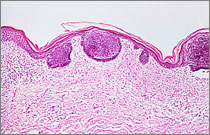Oesophageal Cancer
| 2020 | ||
|---|---|---|
¹ per 100,000 persons, age-standardised according to the old European standard population * calculated using the period method for 2019 / 2020 | ||
| Women | Men | |
| Incidence | 1,720 | 5,660 |
| Age-standardised incidence rate¹ | 2.2 | 9.0 |
| Deaths | 1,398 | 4,556 |
| Age-standardised death rate¹ | 1.7 | 6.9 |
| 5-year prevalence | 2,900 | 10,400 |
| 10-year prevalence | 4,200 | 15,300 |
| Relative 5-year survival rate* | 24 % | 25 % |
| Relative 10-year survival rate* | 18 % | 21 % |
Cancer of the oesophagus causes about 3.6 percent of all cancer deaths in men and 1.3 percent in women. Since 1999, the age-standardised mortality rates for both women and men have remained largely constant. Men in Germany are three times more likely to develop oesophageal cancer than women, and at 68 years of age are on average four years younger at diagnosis than women. For both sexes, the rates in age groups under 60 years are decreasing, while they tend to increase in the higher age groups.
Squamous cell carcinomas account for 41 percent of all cancers of the oesophagus. The proportion of adenocarcinomas, which occur almost exclusively at the junction with the stomach, has risen to 47 percent in recent years. In men, the proportion of adenocarcinomas with 51 percent, is now even considerably higher than that of squamous cell carcinomas.

![]() Distribution of malignant neoplasms ot the oesophagus by histological type and sex, ICD-10 C15, Germany 2015–2016
Distribution of malignant neoplasms ot the oesophagus by histological type and sex, ICD-10 C15, Germany 2015–2016
With relative 5-year survival rates of 24 percent for women and 25 percent for men, oesophageal cancer is among the cancers with unfavourable survival prospects. Only one third of tumours are diagnosed at an early stage (UICC I/II).
Alcohol, smoking and excess weight as important risk factors
In oesophageal cancer, a distinction is made between the more frequent squamous cell carcinoma and the somewhat less frequent adenocarcinoma. The most important risk factors for squamous cell carcinoma of the oesophagus include tobacco and alcohol consumption. The risk of cancer increases with the amount of alcohol consumed daily. If tobacco and alcohol are consumed together, the harmful effect is intensified.
Adenocarcinomas often develop as a result of a gastro-oesophageal reflux disease (continuous reflux of gastric fluid into the oesophagus, chronic heartburn). This leads to changes in the mucous membrane in the lower part of the oesophagus: a so-called Barrett's oesophagus develops, which is considered a cancer precursor. Other important risk factors are excess weight and smoking.
A motility disorder of the oesophagus and the sphincter muscle between the oesophagus and the stomach (achalasia) significantly increases the risk of both squamous cell carcinoma and adenocarcinoma. Familial clustering of oesophageal cancer has also been documented. It is still unclear whether and to what extent hereditary predispositions or environmental factors may be involved.
Date: 21.03.2024






